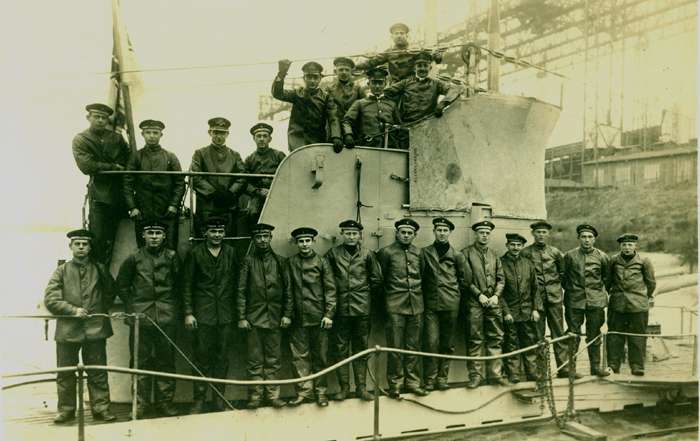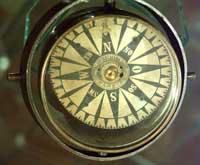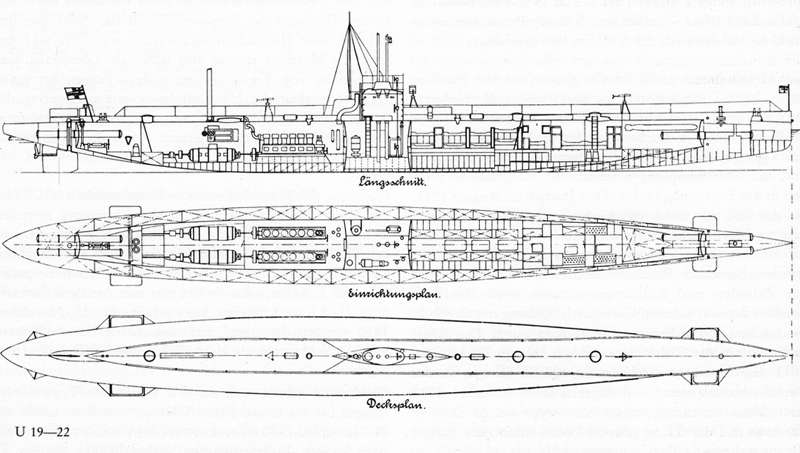It looks indeed good.
U 135

Sadly this boat and I assume most of these crew were lost in the Med.
I keep looking at this amazing photo ..it is haunting..and crossed the years between them and us in some kind of way....i guess it is very moving to me to see, as i had three cousins who were U boat commanders in the next war and none of them came home...i see in these faces personalities, lives, families and people who's history your mod can bring to life and honour. It is worthy work being well done.


Which of these Kapitan's would you choose to serve under?


U 100 Sinking Allied Merchant Ship at sea
Found some new information if you do not know this site, it has uniforms, insignia, badges and much more in good photos:
http://www.ww1medals.net/UC-35.jpg
also found some very good summary from a fine book, Germany High Seas Fleet:
here
http://www.livebinders.com/play/play/92290
re navigation insturments best source is here:
http://landandseacollection.com/id415.html
they carry authentic such, and just sold a WW I German Kaiserliche Submarine Gyro Type III Undeseaboot surrendered Harwich, England in March, 1919
Before 1918, there were outstanding timepieces which the German Navy used for navigation purposes. To that category belong ship chronometers of Hamburg (Brocking, Ruediger Nieberg), Altona (Kessels), Luebeck (Carl Stein), Bremerhaven (W.G. Ehrlich), Nienburg (J. May) and Berlin (F.L. Loebner) and certainly of Glashuette (DUS, Lange) in Saxony, to mention a few. For the Bureau of Ships, the Deutsche Seewarte of the Kaiserliche Marine, there were established reference clocks like the regulator clock by Strasser and Rohde, Paul Stuebner and, of course, Lange & Soehne of Glashuette.

also try the Compass Museum..they have many fine German instruments:
 http://www.compassmuseum.com/nautical/nautical.htm
http://www.compassmuseum.com/nautical/nautical.htm
High seas Fleet info
1916 many additions were made to the U-boat fleet
The U 19 would carry 9 torpedoes of 50 cm. calibre
Improvements were made in all U 40 and U 80 their number of torpedoes increased to 12.
The U 90 would be increased to 16 torpedoes.
The 50 cm. calibre had an explosive charge of 200 kilos.
The minelayer submarines never carried torpedoes, but they did carry 34 to 36 mines.
The small U-boats carried four torpedoes and was armed with just one 5 cm. guns but later they had an increase in demands for more guns and increased the guns to one to two 8.8 cm. They were placed on U-boats, U-B-boats, and U-C-boats.
The 15cm calibre gun was placed on the submarine cruiseres.
February 1, 1917 the U-cruisers were taken over by the Navy and altered for use as a war ship. They were fitted with two 15 cm. calibre guns and two torpedo tubes. It would cary 30 torpedoes.
citation
"Germany's High Sea Fleet in the World War." The Red Fighter Pilot. Web. 28 Apr. 2011. <
http://www.richthofen.com/scheer/scheer14a
Germany's High Sea Fleet in the World War
Chapter 14a - Our U-Boats and their Method of Warfare
IN the year 1916, up to the time of the Battle of the Skagerrak, the following additions had been made to the U-boat fleet: 38 large U-boats, 7 large submarine minelayers, 34 U-B-boats. Two large submarine minelayers, 3 U-B-boats and 3 U-C-boats had still to undergo steam trials; 53 large U-boats, 10 large submarine minelayers, 27 U-B-boats and 66 U-C-boats were under construction. Since the outbreak of war we had lost 21 large U-boats, 1 large submarine minelayer, 6 U-B-boats, 7 U-C-boats, and 2 U-B-boats had been handed over to the Bulgarian Government. The distribution of all the U-boats was so arranged that half were under the orders of the Admirals of the Fleet, and of the rest one half were stationed in the Mediterranean, while the other half, the last quarter, were assigned to the Naval Corps in Flanders. For the sake of quick construction the new types of so-called "U-B "-boats and " U-C "-boats had been introduced, in addition to the main type of large U-boats similar to "U 19," the first one fitted with Diesel engines.
The chief characteristics of the different types were as follows:
"U 19," surface displacement, 650 tons; highest speed on the surface, 12 knots; under water, 9 knots; number of torpedoes, 9, of 50 cm. calibre. Improvements were made in the type. From " U 40 " onwards the displacement was raised first to 700 tons, and from "U 80 " onwards to 800 tons, the speed was raised to 17 knots on the surface, the number of torpedoes increased to 12, and from "U 90 " onwards to 16. The torpedo of 50 cm. calibre had an explosive charge of 200 kilos. The first large submarine minelayers were not armed with torpedoes. They had a displacement of 760 tons, a surface speed of 9.5 knots, and under water 7.5 knots; they carried 34 to 36 mines.
Of the U-B-boats, at first a small number with a displacement of 125 tons was built for use in Flanders, with four torpedoes, speed of 8.5 knots on the surface and 5.5 knots under water. The U-B-boat was then enlarged to 500 tons, with a speed on the surface of 12.5 knots and of 7 under water.
The U-C-boats were of a type designed both for minelaying and firing torpedoes. At first only a small number of these was built, with a displacement of 150 tons; ultimately the boats had a displacement of 400 tons, speed of 11 knots on the surface and 6.5 under water. They carried 18 mines and could take four torpedoes.
At the beginning the U-boats were armed with one 5 cm. gun as a defence against enemy submarines. But as their use was developed in the war, such various demands were made upon them that their armament had to be increased. One or two guns of 8.8 cm. were placed on the U-boats, U-B-boats, and the U-C-boats; the submarine cruisers were in part armed with a gun of 15 cm. calibre.
The majority of the large U-boats was assigned to the Fleet for use in the blockaded area west of England. The length of their trips was 21 to 28 days, but this was also dependent on the amount of ammunition used when the boats had found a favourable opportunity to fire their torpedoes soon after leaving port. The big minelayers were also under the command of the Fleet, and could be sent on distant expeditions—to the White Sea or to the Mediterranean.
The U-B-boats, being rather smaller, had proved to be very handy and quickly submersible, although they could not remain so long at sea. They were, therefore, mainly assigned to the base in Flanders, as were the U-C-boats, of which a small number, however, was at the disposal of the Fleet and used for laying mines on the east coast of England. The distribution of the boats among the various bases was carried out according to the facilities the latter had for repairing the boats on their return from expeditions. The large amount of technical apparatus in a U-boat required very careful overhauling and repair on her return from an expedition; also the damage due to the voyage or to enemy attacks had to be repaired. Generally speaking, after four weeks at sea a boat would need to lie in the dockyard for the same length of time for repairs. The Imperial dockyard at Wilhelmshaven had been enlarged and was the chief place to which the U-boats of the Fleet were sent for repair. The docks at Kiel and Danzig were needed for other purposes; the bases at Zeebrugge and Pola were used at first mainly for overhauling the boats. Until these dockyards had been altered so as to be able to undertake more extensive work the boats which belonged there had to return home for important repairs.
When the U-boat campaign was opened on February 1, 1917, there were 57 boats already in the North Sea. The officer commanding the Baltic district had eight assigned to him, the Naval Corps in Flanders had at its disposal 38, and the stations in the Mediterranean 31 U-boats of different types. The favourable experiences of the commercial U-boat U-Deutschland had led to the construction of U-cruisers, of which the first series had a displacement of 1,200 tons, which was later on raised to 2,000 and more. When they could no longer be used for trade purposes the commercial U-boats were taken over by the Navy and altered for use as warships. They were fitted with two guns of 15 cm. calibre and two torpedo tubes, and could carry about 30 torpedoes in accordance with the extended period during which they could be used on cruises, cruises which reached as far as the Azores and lasted up to three months. With this fleet of U-boats the Navy was well equipped to do justice to the task assigned to it, although England had used the whole of 1916 to develop her defence. The sinkings of the year 1917 prove this. They were:
February, 1917 781,500 tons
March, 885,000 "
April, 1,091,000 "
May, 869,000 "
June, 1,016,000 "
July, 811,000 "
August, 808,000 "
September, 672,000 "
October, 674,000 "
November, 607,000 "
December, 702,000 "
January, 1918 632,000 "
February, 680,000 "
March, 689,000 "
April, 652,000 "
May, 614,000 "
June, 521,000 "
July, 550,000 "
August, 420,000 "
September, 440,000 "
The enemy's defence consisted, firstly, in directly combating the U-boats, and, secondly, in special measures which England adopted to counterbalance the loss of tonnage. The first impediment our U-boats had to overcome—I am speaking of the activities of the U-boats assigned to the Fleet (the same applies to the Flanders boats), whereas those in the Mediterranean mostly worked under less difficult conditions—lay in the minefields blocking the North Sea. To deal successfully with these the Fleet had had to create a special organisation. In addition to the actual mine-sweepers, whose work it was to keep certain paths through the belt of mines clear, special convoying flotillas had been formed, fitted with minesweeping apparatus, which accompanied the U-boats along the routes that had been cleared, till they reached the open sea, and met them at the same spot on their return from their fields of operation to take them safely home again. When attacking steamers the boats had to reckon with their armament, for in spite of the large number of guns required and the crews to man them, nearly the whole of the English Merchant Fleet—at any rate all the more valuable steamers—was armed.
As a further defence, besides the destroyers which were excellently suited to this purpose and were armed with depth charges, a large number of new kinds of boats with shallow draft had been built especially to combat the U-boats. Nets and all sorts of wire entanglements hindered the U-boats in their work near the English coast. The so-called "Q "-boats, intended to serve as traps for submarines, were specially fitted out; they presented the appearance of neutral ships, and on the approach of the U-boat let fall their disguise and attempted to destroy it with guns and explosives. The practice of gathering considerable numbers of British merchantmen together and convoying them added greatly to the difficulties the U-boat encountered in achieving success; these ships were protected according to their size and value either by light craft or by bigger warships.
During the first months of the U-boat campaign I never missed an opportunity of hearing the story of his experiences and adventures direct from the lips of the commander of a returning U-boat; and thus I had opportunity to form an idea of the perseverance, courage and resolution of these young officers who won my highest admiration for the seamanship and the calm intrepidity, which they succeeded in communicating to the crew as well. It is a splendid testimonial to the spirit of the Navy that all who could possibly be considered suitable for the U-boat service, both officers and men, rushed to offer themselves. Even older Staff officers, in spite of their many years of service, begged to be taken as commanders of U-boats, even if they had to serve under a flotilla commander younger than themselves.
The three half-flotillas into which the U-boats of the Fleet lied been formed at the beginning of the war developed in time into four flotillas. Their commanders were: First U-Flotilla, Commander Pasgnay; Second U-Flotilla, Commander von Rosenberg; Third U-Flotilla, Lieutenant-Commander Forstmann (Walter); Fourth U-Flotilla, Commander Pranse. I should like to mention in connection with these Lieutenant-Commander Bartenbach, who was at the head of the U-flotilla in Flanders, who so often supported the enterprises of the Fleet with his boats. In an exemplary manner, despite all obstacles, he directed the difficult operations of the Flanders boats, against which the British defence was particularly heavy. All who served with him were animated by a spirit of comradeship and readiness for action, which had the most refreshing and grateful effect upon anyone who spent any time with them.
The Chief Director of the U-boats under the command of the Fleet was Captain Bauer; he himself took part in the fighting expeditions of the U-boats in the blockaded area round England, in order to be able to form his own opinion of the circumstances in which the boats under his command had to operate. It is his great merit that he recognised the capacity of the U-boat and brought it to that degree of efficiency to which its later successes are due. When, later on, owing to the increasing activity in construction, the number of U-boats grew to such an extent that their organisation far surpassed that required for a squadron and demanded a corresponding increase in authority, Commodore Michelsen, who had hitherto commanded the torpedo-boats, was placed at the head. His great knowledge and experience of the department of torpedoes designated him as particularly suitable for this post, and he completely fulfilled all expectations in this respect.
The U-boat service was the one which suffered the heaviest losses of the Navy; the number of boats lost on fighting expeditions amounted to 50 per cent. Altogether 360 U-boats and U-boat cruisers were employed in the U-boat campaign, of which 184 were lost in the course of their enterprises. This high percentage of losses was for the most part due to the defence of the enemy, which grew more and more vigorous, as he tried to get the better of the U-boat danger by the use of all sorts of dodges and methods; yet a large proportion is ascribable to the fact that our U-boat commanders could not resist the temptation, when sinking a steamer, to save the lives of those on board as far as possible, even though they so often met with disappointment.
I should like to illustrate the difficulties encountered by our U-boats by a few instances, quoting the official reports concerning them. But it would be impossible to do all the commanders equal justice, for they vied with each other in meeting the dangers which their difficult business involved, and with which the public are already familiar through various popular writings.
Kaisermarine Biloculars:

Deck Plan of U 20 which sank Lusitania...which turned out WAS carrying millions of rounds of small arms ammunition
